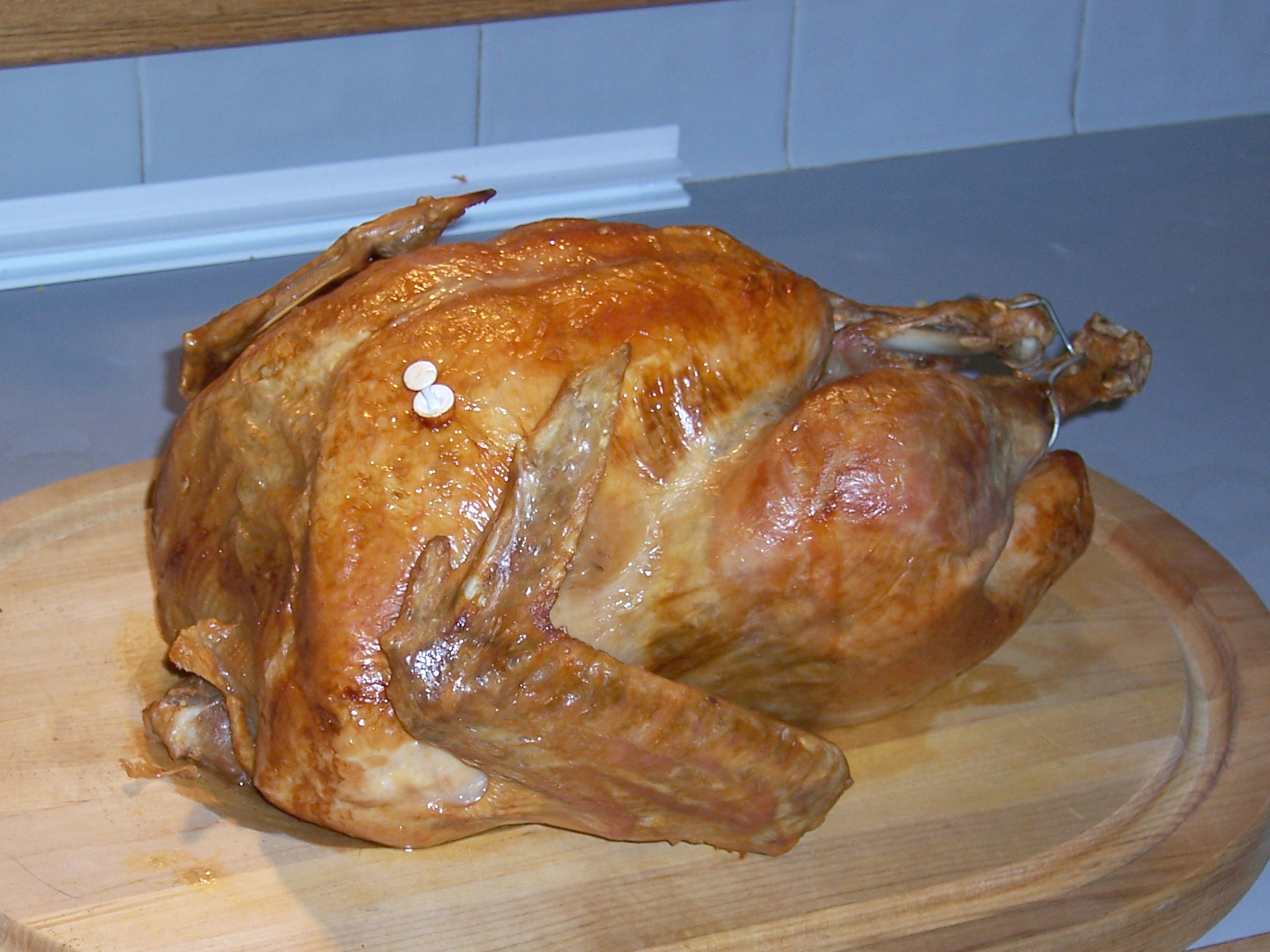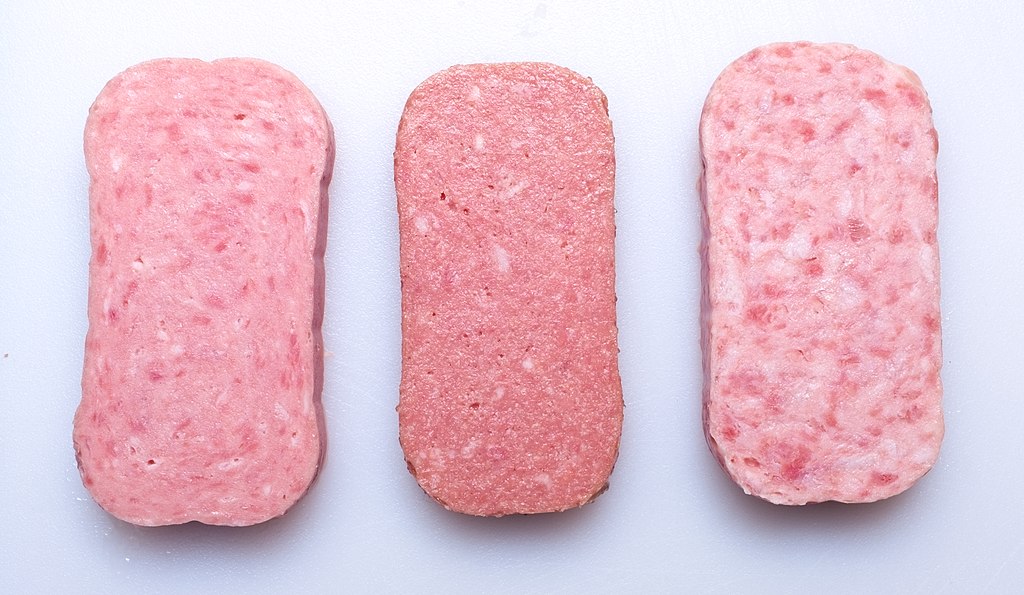Turkey vs. Spam
Nutrition comparison of Cooked Turkey and Spam
Ever wonder how your favorite foods stack up against each other in terms of nutrition?
We compared the nutritional contents of
cooked
turkey
versus
spam
(100g each)
below using 2020 USDA and NIH data[1].
For a quick recap of significant nutrients and differences in turkey and spam:
- Both turkey and spam are high in calories, potassium and protein.
- Spam has more thiamin, however, turkey contains more niacin, pantothenic acid and Vitamin B6.
- Spam is an excellent source of Vitamin C.
USDA sources for nutritional information: Turkey (Turkey, whole, meat and skin, cooked, roasted) and Spam (Luncheon meat, pork, ham, and chicken, minced, canned, reduced sodium, added ascorbic acid, includes SPAM, 25% less sodium) . Have a correction or suggestions? Shoot us an email.
Calories and Carbs
calories
Both turkey and spam are high in calories. Spam has 55% more calories than turkey - turkey has 189 calories per 100 grams and spam has 293 calories.
For macronutrient ratios, turkey is much heavier in protein, lighter in carbs and much lighter in fat compared to spam per calorie. Turkey has a macronutrient ratio of 63:0:37 and for spam, 17:5:78 for protein, carbohydrates and fat from calories.
Macro Ratios from Calories:
| Turkey | Spam | |
|---|---|---|
| Protein | 63% | 17% |
| Carbohydrates | ~ | 5% |
| Fat | 37% | 78% |
| Alcohol | ~ | ~ |
carbohydrates
Both turkey and spam are low in carbohydrates - turkey has 0.06g of total carbs per 100 grams and spam has 3.4g of carbohydrates.
Protein
protein
Both turkey and spam are high in protein. Turkey has 128% more protein than spam - turkey has 28.6g of protein per 100 grams and spam has 12.5g of protein.
Fat
saturated fat
Spam is high in saturated fat and turkey has 76% less saturated fat than spam - turkey has 2.2g of saturated fat per 100 grams and spam has 8.9g of saturated fat.
trans fat
Both turkey and spam are low in trans fat - turkey has 0.1g of trans fat per 100 grams and spam does not contain significant amounts.
cholesterol
Spam has 30% less cholesterol than turkey - turkey has 109mg of cholesterol per 100 grams and spam has 76mg of cholesterol.
Vitamins
Vitamin C
Spam is an excellent source of Vitamin C and it has more Vitamin C than turkey - spam has 43mg of Vitamin C per 100 grams and turkey does not contain significant amounts.
Vitamin A
Turkey has more Vitamin A than spam - turkey has 12ug of Vitamin A per 100 grams and spam does not contain significant amounts.
Vitamin D
Turkey and spam contain similar amounts of Vitamin D - turkey has 15iu of Vitamin D per 100 grams and spam has 23iu of Vitamin D.
Vitamin E
Turkey and spam contain similar amounts of Vitamin E - turkey has 0.07mg of Vitamin E per 100 grams and spam has 0.24mg of Vitamin E.
The B Vitamins
Spam has more thiamin, however, turkey contains more niacin, pantothenic acid and Vitamin B6. Both turkey and spam contain significant amounts of riboflavin, folate and Vitamin B12.
| Turkey | Spam | |
|---|---|---|
| Thiamin | 0.045 MG | 0.264 MG |
| Riboflavin | 0.281 MG | 0.179 MG |
| Niacin | 9.573 MG | 3.175 MG |
| Pantothenic acid | 0.948 MG | ~ |
| Vitamin B6 | 0.616 MG | 0.283 MG |
| Folate | 9 UG | 4 UG |
| Vitamin B12 | 1.02 UG | 0.61 UG |
Minerals
calcium
Turkey has more calcium than spam - turkey has 14mg of calcium per 100 grams and spam does not contain significant amounts.
iron
Turkey has 70% more iron than spam - turkey has 1.1mg of iron per 100 grams and spam has 0.64mg of iron.
potassium
Both turkey and spam are high in potassium. Spam has 136% more potassium than turkey - turkey has 239mg of potassium per 100 grams and spam has 564mg of potassium.
Omega-3 and Omega-6
omega 3s
For omega-3 fatty acids, spam has more alpha linoleic acid (ALA) than turkey per 100 grams.
| Turkey | Spam | |
|---|---|---|
| alpha linoleic acid | 0.108 G | 0.23 G |
| DHA | 0.005 G | ~ |
| EPA | 0.008 G | ~ |
| DPA | 0.008 G | ~ |
| Total | 0.129 G | 0.23 G |
omega 6s
Comparing omega-6 fatty acids, both turkey and spam contain significant amounts of linoleic acid.
| Turkey | Spam | |
|---|---|---|
| other omega 6 | 0.01 G | ~ |
| linoleic acid | 1.873 G | 2.436 G |
| Total | 1.883 G | 2.436 G |
Customize your serving size
The comparison below is by common portions, e.g. cups, packages. You can also see a more concrete comparison by weight at equal weight (by grams) comparison.
Cooked Turkey g
()
|
Daily Values (%) |
Spam g
()
|
|||||
|---|---|---|---|---|---|---|---|
| KCAL % |
|
5% | calories | 5% |
|
KCAL % | |
| G % |
|
5% | carbohydrates | 5% |
|
G % | |
| G % |
|
5% | dietary fiber | 5% |
|
G % | |
| G | 5% | sugar | 5% | G | |||
| G % |
|
5% | total fat | 5% |
|
G % | |
| G % |
|
5% | saturated fat | 5% |
|
G % | |
| G | 5% | monounsaturated fat | 5% | G | |||
| G | 5% | polyunsaturated fat | 5% | G | |||
| G | 5% | trans fat | 5% | G | |||
| MG | 5% | cholesterol | 5% | MG | |||
| MG % |
|
5% | sodium | 5% |
|
MG % | |
| 5% | Vitamins and Minerals | 5% | |||||
| UG % |
|
5% | Vitamin A | 5% |
|
UG % | |
| MG % |
|
5% | Vitamin C | 5% |
|
MG % | |
| IU % |
|
5% | Vitamin D | 5% |
|
IU % | |
| MG % |
|
5% | calcium | 5% |
|
MG % | |
| MG % |
|
5% | iron | 5% |
|
MG % | |
| MG % |
|
5% | magnesium | 5% |
|
MG % | |
| MG % |
|
5% | potassium | 5% |
|
MG % | |
| MG % |
|
5% | thiamin (Vit B1) | 5% |
|
MG % | |
| MG % |
|
5% | riboflavin (Vit B2) | 5% |
|
MG % | |
| MG % |
|
5% | niacin (Vit B3) | 5% |
|
MG % | |
| MG % |
|
5% | Vitamin B6 | 5% |
|
MG % | |
| MG % |
|
5% | pantothenic acid (Vit B5) | 5% |
|
MG % | |
| UG % |
|
5% | folate (Vit B9) | 5% |
|
UG % | |
| UG % |
|
5% | Vitamin B12 | 5% |
|
UG % | |
| MG % |
|
5% | Vitamin E | 5% |
|
MG % | |
| UG % |
|
5% | Vitamin K | 5% |
|
UG % | |
| G % |
|
5% | protein | 5% |
|
G % | |
| UG % |
|
5% | biotin (Vit B7) | 5% |
|
UG % | |
| MG % |
|
5% | choline | 5% |
|
MG % | |
| MG % |
|
5% | chlorine | 5% |
|
MG % | |
| UG % |
|
5% | chromium | 5% |
|
UG % | |
| MG % |
|
5% | copper | 5% |
|
MG % | |
| UG % |
|
5% | fluoride | 5% |
|
UG % | |
| UG % |
|
5% | iodine | 5% |
|
UG % | |
| MG % |
|
5% | manganese | 5% |
|
MG % | |
| UG % |
|
5% | molybdenum | 5% |
|
UG % | |
| MG % |
|
5% | phosphorus | 5% |
|
MG % | |
| UG % |
|
5% | selenium | 5% |
|
UG % | |
| MG % |
|
5% | zinc | 5% |
|
MG % | |
| G | 5% | Water | 5% | G | |||
| G | 5% | Starch | 5% | G | |||
| G | 5% | Alcohol | 5% | G | |||
FAQ
Does turkey or spam contain more calories in 100 grams?Both turkey and spam are high in calories. Spam has 60% more calories than turkey - turkey has 189 calories in 100g and spam has 293 calories.
Is turkey or spam better for protein?
Both turkey and spam are high in protein. Turkey has 130% more protein than spam - turkey has 28.6g of protein per 100 grams and spam has 12.5g of protein.
Does turkey or spam contain more potassium?
Both turkey and spam are high in potassium. Spam has 140% more potassium than turkey - turkey has 239mg of potassium in 100 grams and spam has 564mg of potassium.

